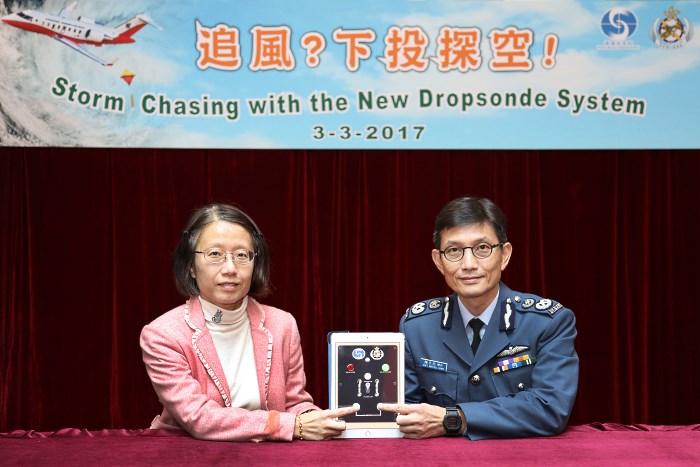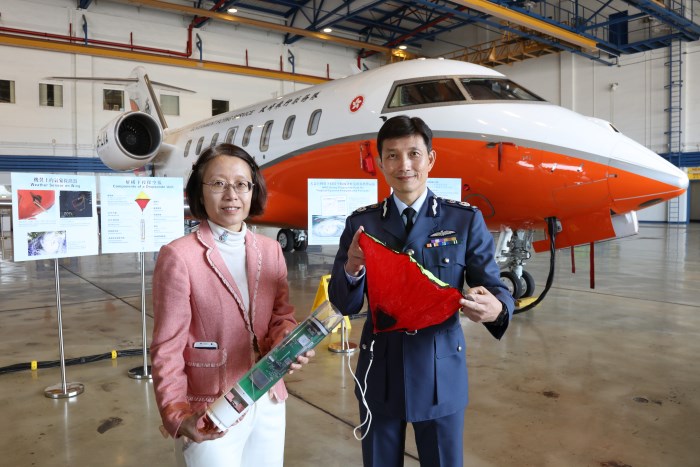HKO and GFS join forces to introduce dropsonde system
3 March 2017
The Hong Kong Observatory (HKO) and the Government Flying Service (GFS) held a joint press conference entitled “Storm Chasing with the New Dropsonde System” today (March 3) on the jointly introduced dropsonde system, which collects extra meteorological data on tropical cyclones to enhance the monitoring of typhoons.
Speaking at the joint press conference, the Controller of the GFS, Captain Michael Chan, said, “The new fixed-wing aircraft of the GFS commenced service in 2016. In addition to a high-frequency weather data probe which came with the aircraft, a new dropsonde system was installed. After flight operation assessments, the system performed its first mission in September 2016 when Typhoon Megi traversed the northern part of the South China Sea. The dropsonde mission was successfully completed. The GFS will work closely with HKO in the future such that, when tropical cyclones enter the South China Sea and may affect Hong Kong, the fixed-wing aircraft will be deployed where feasible to collect more meteorological data.”
The Assistant Director of the HKO, Ms Sharon Lau, said the use of the dropsonde system enables first-hand meteorological data to be collected at various altitudes of the atmosphere, complementing the lack of conventional weather observations over the ocean, and facilitating the HKO in the analysis of the intensity and three-dimensional structure of tropical cyclones. The experience of similar dropsonde measurements suggests that the use of such collected data in numerical weather prediction models could help improve the prediction of typhoons.
The forecasting and warning of tropical cyclones rely on accurate meteorological measurements. Dropsonde technology uses an aircraft to release the dropsonde unit from a high altitude. The dropsonde unit contains meteorological measurement sensors and a global positioning system which record weather information such as wind direction, wind speed, temperature, air pressure and humidity at different altitudes during descent. The data are then transmitted back to the aircraft through a radio communication device. The meteorological data collected at various heights around a tropical cyclone, particularly the wind direction, wind speed and pressure readings near the sea surface, are valuable for the HKO to determine the location and intensity of the storm. Last year, a total of four missions were performed during the passage of Typhoon Megi and Tropical Storm Aere over the South China Sea.
A video about the dropsonde system jointly introduced by the HKO and the GFS can be viewed at the HKO’s YouTube channel: www.youtube.com/watch?v=-VWla0bFNvE.

Figure 1 : The Controller of the Government Flying Service, Captain Michael Chan (right), and the Assistant Director of the Hong Kong Observatory, Ms Sharon Lau (left), introduced the dropsonde system at a joint press conference today (March 3).

Figure 2 : The Controller of the Government Flying Service, Captain Michael Chan (right), and the Assistant Director of the Hong Kong Observatory, Ms Sharon Lau (left), introduced the dropsonde system at a joint press conference today (March 3). They are pictured holding a dropsonde unit.